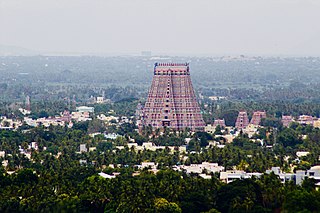
Srirangam is a neighbourhood in the city of Tiruchirappalli in the Indian state of Tamil Nadu. A river island, Srirangam is bounded by the Kaveri River on one side and its distributary Kollidam on the other side. Considered as the first among the 108 Divya Desams, a group of Vishnu temples, it is famous for the Ranganathaswamy Temple, the largest temple complex in India and the biggest functioning Hindu temple in the world. Srirangam is also home to a significant population of Sri Vaishnavas.
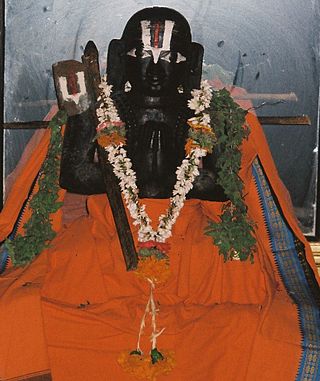
Ramanuja, also known as Ramanujacharya, was an Indian Hindu philosopher, guru and a social reformer. He is noted to be one of the most important exponents of the Sri Vaishnavism tradition within Hinduism. His philosophical foundations for devotionalism were influential to the Bhakti movement.
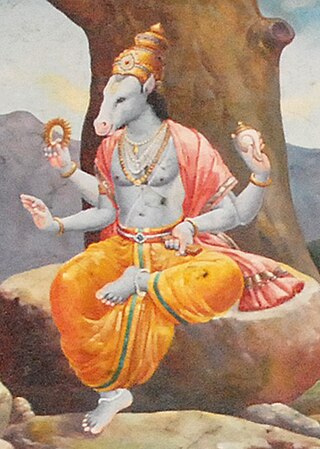
Hayagriva is a Hindu deity, the horse-headed avatar of Vishnu. The purpose of this incarnation was to slay a danava also named Hayagriva, who had the head of a horse and the body of a human.

Vedanta Desika (1268–1369), also rendered Vedanta Desikan, Swami Vedanta Desika, and Thoopul Nigamantha Desikan, was an Indian polymath who wrote philosophical as well as religious and poetical works in several languages, including Sanskrit, Manipravaḷam, Tamil and Prakrit. He was an Indian philosopher, Sri Vaishnava guru, and one of the most brilliant stalwarts of Sri Vaishnavism in the post-Ramanuja period. He was a Hindu devotee, poet, Master of Acharyas (desikan) and a logician and mathematician. He was the disciple of Kidambi Appullar, also known as Athreya Ramanujachariar, who himself was of a master-disciple lineage that began with Ramanuja. Vedanta Desika is considered to be avatar (incarnation) of the divine bell of Venkateshvara of Tirumala by the Vadakalai sect of Sri Vaishnavism. Vedanta Desika belongs to Vishvamitra/Kaushika gotra.

A matha, also written as math, muth, mutth, mutt, or mut, is a Sanskrit word that means 'institute or college', and it also refers to a monastery in Hinduism. An alternative term for such a monastery is adheenam. The earliest epigraphical evidence for mathas related to Hindu-temples comes from the 7th to 10th century CE.
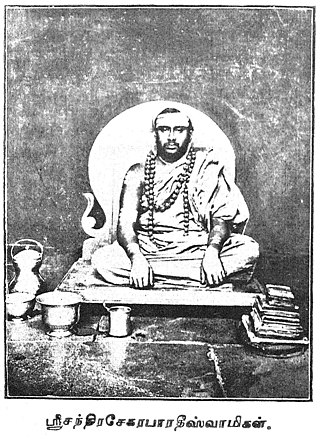
Swami Chandrasekhara Bharati was the Jagadguru Sankaracarya of Sringeri Sharada Peetham in 1912–1954. He was one of the known spiritual figures in Hinduism during the 20th century. He is a Jivanmukta.

The Ranganathaswamy Temple is a Hindu temple dedicated to Ranganatha and his consort Ranganayaki. The temple is located in Srirangam, Tiruchirapalli, Tamil Nadu, India. Constructed in the Dravidian architectural style, the temple is glorified by the Tamil poet-saints called the Alvars in their canon, the Naalayira Divya Prabhandam, and has the unique distinction of being the foremost among the 108 Divya Desams dedicated to the god Vishnu. The Srirangam temple stands as the largest religious complex in the world in active worship with a continuous historical presence as a Hindu temple. Some of these structures have been renovated, expanded and rebuilt over the centuries as a living temple. The latest addition is the outer tower that is approximately 73 metres (240 ft) tall, which was completed in 1987 with support from the Ahobila mutt among others. The temple is an thriving Hindu house of worship and follows the Tenkalai tradition of Sri Vaishnavism, based on the Pancharatra agama. The annual 21-day festival conducted during the Tamil month of Margali (December–January) attracts 1 million visitors. The temple complex has been nominated as a UNESCO World Heritage Site, and is in UNESCO's tentative list. In 2017 the temple won the UNESCO Asia Pacific Award of Merit 2017 for cultural heritage conservation, making it the first temple in Tamil Nadu to receive the award from the UNESCO.

Melukote in Pandavapura taluk of Mandya district, Karnataka, in southern India, is one of the sacred places in Karnataka.It is built on rocky hills, known as Yadugiri, Yaadavagiri or Yadushaila, overlooking the Cauvery valley. Melukote is about 51 km from Mysore and 133 km (83 mi) from Bangalore.

Alagiya Manavalan, best known by his epithet Manavala Mamunigallit. 'The great saint, Manavalan' (1370–1450), was a Hindu theologian. He was a major proponent of the Sri Vaishnavism tradition in the 15th century in Tamilakam, disseminating it with the help of his eight disciples. The disciples of Manavalan established places of learning to teach the Vishishtadvaita philosophy in Tamilakam.
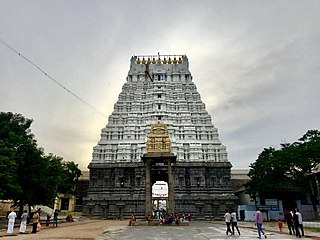
Varadharaja Perumal Temple, also called Hastagiri, Attiyuran,Attigiri, Perarulalan Perumal temple, Kanchi koil, Thirukatchi, or Perumal koil is a Hindu temple dedicated to Vishnu located in the city of Kanchipuram, Tamil Nadu, India. It is one of the Divya Desams, the 108 temples of Vishnu believed to have been visited by the 12 poet saints, or the Alvars. It is located in a suburb of Kanchipuram known as the Vishnu Kanchi that is a home for many famous Vishnu temples. One of the greatest Hindu scholars of Vaishnava Vishishtadvaita philosophy, Ramanuja, is believed to have resided in this temple.
The Srirangam Srimad Andavan Ashramam is a Hindu institution of the Sri Vaishnava tradition dedicated to the propagation of Ramanuja's and Vedanta Desika's philosophy of Vishishtadvaita. The head of the institution is known as the "Andavan" or "Andavan Swamigal", a title that is believed to be given by the deity Ranganatha himself to the first seer.

Sri Vaishnavism is a denomination within the Vaishnavism tradition of Hinduism, predominantly practiced in South India. The name refers to goddess Lakshmi, as well as a prefix that means "sacred, revered", and the god Vishnu, who are together revered in this tradition.

Veeraraghava Swamy Temple is a temple dedicated to the Hindu god Vishnu, located in Tiruvallur, Chennai Metropolitan City, an area and headquarters in Tiruvallur district in the South Indian state of Tamil Nadu. Constructed in Dravidian style of architecture, the temple is glorified in the Divya Prabandham, the early medieval Tamil canon of the Alvar saints from the 6th–9th centuries CE. It is counted as one among the 108 Divya Desams dedicated to Vishnu. Vishnu is worshipped as Veeraraghava Perumal, and his consort Lakshmi as Kanakavalli Thayar.

The Ahobila Matha is a Vadakalai Sri Vaishnava monastery established around 1400 CE at Ahobilam in Andhra Pradesh, India following the Vadakalai tradition of Vedanta Desika. It was founded by Sri Adivan Satakopa Swami(An acharya for both Thenkalai and Vadakalai Srivaishnava traditions, known in purvashrama as Thirunarayanapuram Kidambi Srinivasacharya). by the divine order of Sri Ahobila Narasimha.

Shri Gaudapadacharya Math, also known as Kavaḷē maṭha, located in Kavale, Ponda, Goa, is the oldest matha of the Smarthan Saraswat Brahman Samaj. It was founded by Gauḍapāda around 740 AD, whose student was Govinda Bhagavatpada, the guru of Adi Shankara, a highly influential figure in Hinduism. There is also a belief that Gauḍapāda himself established the Shri Gaudapadacharya matha when he lived in Gomantak (Goa). Thus, the matha came to be known as Shri Saunstan Gaudapadacharya matha. Unlike other mathas, Shri Gaudapadacharya matha is not a polemical center established to influence the faith of all Hindus, its jurisdiction is limited to only Dakshinatya Saraswat Brahmins. The Peetadhipathi "head monk" is Śrī Gauḍapadācārya. Smartist Goud Saraswat Brahman Samaj and Rajapur Saraswat Brahmin are its main disciples.

Lakshmi Kumara Tatacharya, (1571–1643) was a prominent saint and guru of the Sri Vaishnava tradition of Hinduism. He served as the rajaguru for a ruler of the Vijayanagara Empire, Venkatapati Raya. He was also the overseer of a number of sacred temples known as the Divya Desams, including Srirangam, Kanchipuram, Tirumala, Melkote, and Srivilliputtur.
Thiruvanthipuram is a revenue village in Cuddalore district of Tamil Nadu, India.

Vaduvur Veeravalli Srinivasa Desikachariar was an Indian scholar. He studied Sanskrit and published several books. In 2001, he received the Rashtrapathi Award from the President of India as a Sanskrit scholar, one of the highest awards awarded by the Indian state.
Hinduism in Tamil Nadu finds its earliest literary mention in the Sangam literature dated to the 5th century BCE. The total number of Tamil Hindus as per 2011 Indian census is 63,188,168 which forms 87.58% of the total population of Tamil Nadu. Hinduism is the largest religion in Tamil Nadu.

Vishvaksena or Vishwaksena, is the commander-in-chief of the army of the Hindu deity Vishnu, additionally serving as a gatekeeper and chamberlain of his celestial abode of Vaikuntha. As the embodiment of the tantras, Vishvaksena is worshipped before any ritual or function in the Vaikhanasas and Sri Vaishnavism sects. He occupies an important place in Vaikhanasa and Pancaratra temple traditions, where temple festivals often begin with his worship and procession.






























